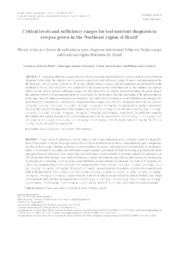Critical levels and sufficiency ranges for leaf nutrient diagnosis in cowpea grown in the Northeast region of Brazil.
Critical levels and sufficiency ranges for leaf nutrient diagnosis in cowpea grown in the Northeast region of Brazil.
Autoria: MELO, F. de B.; SOUZA, H. A. de; BASTOS, E. A.; CARDOSO, M. J.
Resumo: Proposing sufficiency ranges and critical levels is an important technique for correct evaluation of leaf nutrient diagnosis. In this study, the objective was to propose critical levels and sufficiency ranges of macro- and micronutrients for the diagnostic leaf of cowpea, collected at flowering, with the results of macro- and micronutrients and productivity in the Northeast of Brazil. The critical level was calculated by the reduced normal distribution and by the boundary line method, which was also used to generate sufficiency ranges. For the critical level by reduced normal distribution, the relationship of the nutrients with 90% of maximum productivity was adopted. For the boundary line, the relationship of the nutrients that are in the upper line of a dispersion diagram was considered. The critical levels by reduced normal distribution for nitrogen (N), phosphorus (P), potassium (K), calcium (Ca), magnesium (Mg), copper (Cu), iron (Fe), manganese (Mn) and zinc (Zn) are: 35.3 g kg-1, 1.8 g kg-1, 20.5 g kg-1, 11.1 g kg-1, 2.6 g kg-1, 3.2 mg kg-1, 105 mg kg-1, 89 mg kg-1and 22 mg kg-1, respectively. However, the critical levels generated by the boundary line for N, P, K, Ca, Mg, Cu, Fe, Mn and Zn are 39.5 g kg-1, 2.3 g kg-1, 21.2 g kg-1, 11.3 g kg-1, 2.9 g kg-1, 4.2mg kg-1, 142 mg kg-1, 143mg kg-1 and 24 mg kg-1, respectively. The sufficiency ranges by the boundary line method, to achieve 95% of maximum productivity, are equivalent to 34.4-44.7g kg-1, 1.7-2.9 g kg-1,18.6-23.6 g kg-1,8.8-13.7 g kg-1,2.3-3.5 g kg-1,3.1-5.4 mg kg-1,73-210 mg kg-1,104-181 mg kg-1 and 22-27 mg kg-1 for N, P, K, Ca, Mg, Cu, Fe, Mn and Zn, respectively.
Ano de publicação: 2020
Tipo de publicação: Artigo de periódico
Unidade: Embrapa Meio-Norte
Palavras-chave: Cowpeas, Feijão de Corda, Folha, Nutriente Mineral, Nutrição Vegetal, Plant micronutrients, Plant nutrition, Vigna, Vigna Unguiculata
Observações
1 - Por padrão são exibidas publicações dos últimos 20 anos. Para encontrar publicações mais antigas, configure o filtro ano de publicação, colocando o ano a partir do qual você deseja encontrar publicações. O filtro está na coluna da esquerda na busca acima.
2 - Para ler algumas publicações da Embrapa (apenas as que estão em formato ePub), é necessário ter, no celular ou computador, um desses softwares gratuitos. Sistemas Android: Google Play Livros; IOS: iBooks; Windows e Linux: software Calibre.
Acesse outras publicações
Acesse a Base de Dados da Pesquisa Agropecuária (BDPA) para consultar o acervo completo das bibliotecas da Embrapa.

